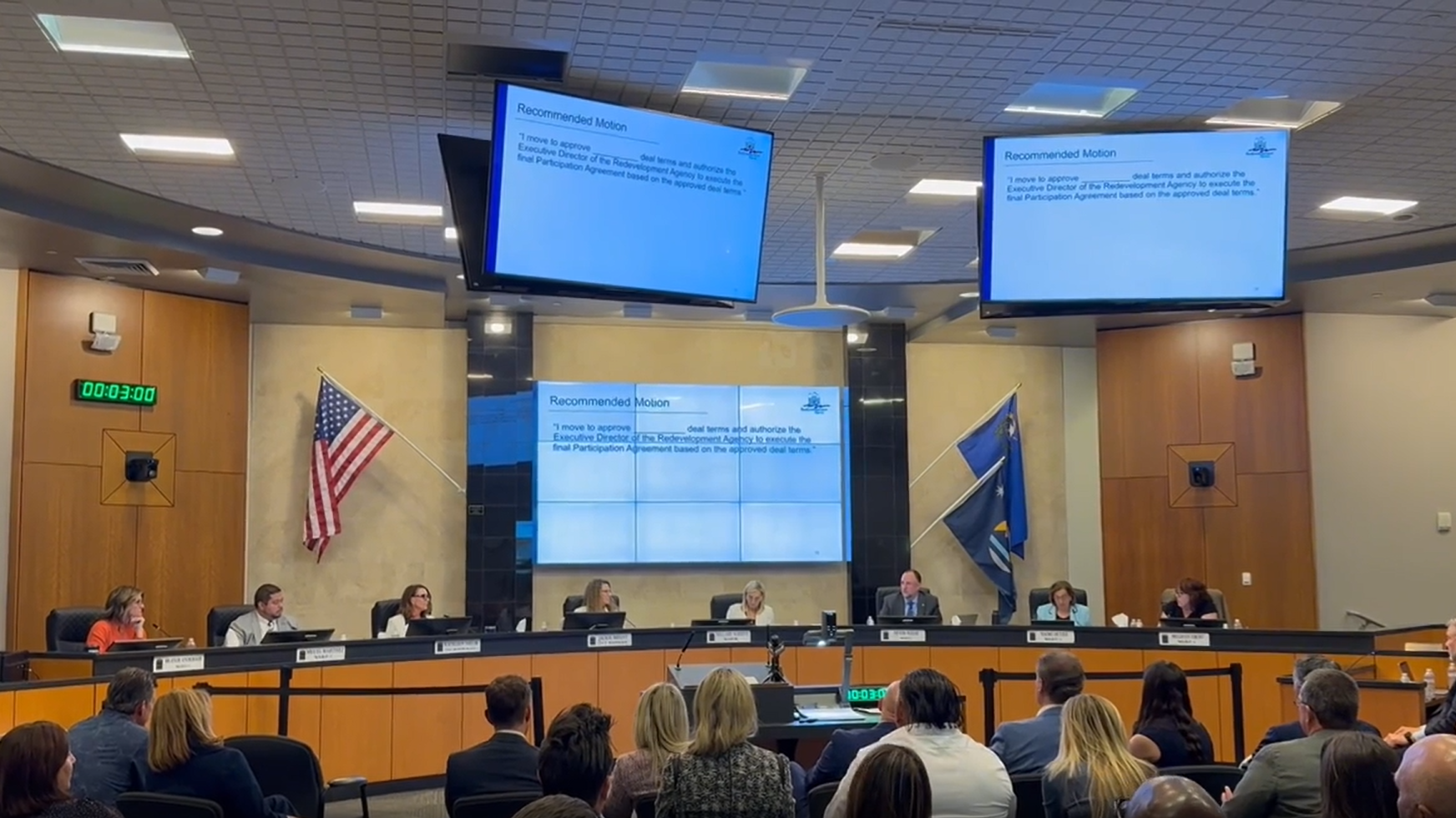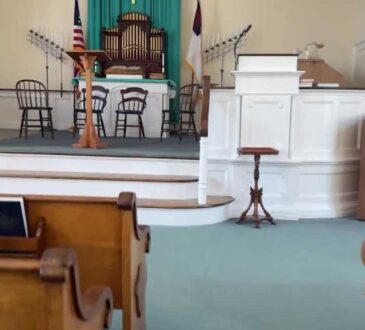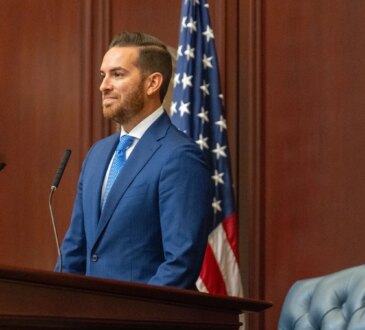
Reno redevelopment agency approves GSR arena project TIF contract
Reno’s redevelopment agency voted 5-2 to approve the GSR arena project’s tax-increment financing contract.
The Reno redevelopment agency, which is made up of the city council members, voted in 5-2 to approve the tax-incremental financing contract with the Grand Sierra Resort’s phase one arena project.
The deal would require GSR to be reimbursed 90% of its property tax, while the redevelopment agency would keep 10% of the property taxes. It sunsets in 2035.
GSR owner Alex Meruelo said he would give the lease to the property of Fire Station 21 to the city, and give an additional 5% of the 90% property tax reimbursement earnings to youth sports recreation facilities.
“Everything I’ve heard from every single one of you has impacted me. It’s going to affect me more personally, but it’s what I have to do,” Meruelo said. “I would like to fight for Ward 3.”
Mayor Hillary Schieve said she was grateful someone was willing to invest in the city with a huge project like this.
“We don’t have a lot of economic development tools … so in order to make things work, we have to do private-public partnerships,” Schieve said. “With this TIF plan, someone has to be willing to make the investment and I haven’t seen a lot of that yet.”
“I want to send a message to the outside world that Reno is doing something.”
However, other council members were more worried about the effects on the city.
Council member Kathleen Taylor said she believes this is a great investment, but many residents in her ward have asked her to deny the project, and that’s why she voted no.
Council member Naomi Duerr said she wanted to make sure there are community benefits coming with this project, and not just a tourist, casino and city benefit. However, she supports the project and wanted to make sure someone was asking the “hard questions.”
“I’m just wondering why the city of Reno should use our public funds for a private business?” Council member Meghan Ebert asked. “I’m just not exactly sure why this particular investment should make sense to us, knowing that our downtown is in the shape that it is.”
Council member Devon Reese argued that it’s better than the zero dollars that come from no development there.
The project received two hours of public comment, as well as 600 letters of support submitted on behalf of the GSR project and roughly 30 letters against.
A breakdown of the finances
Phase 1 of the GSR project includes the 10,0000-seat arena, 2,400-spot parking garage, an aqua golf driving range and a 50,000-square-foot community ice rink.
The cost for just this phase is $786 million. The project has a projected $145.8 million gap, but the city will only be filling roughly $68 million of that gap with the tax-incremental financing plan.
“The TIF doesn’t even cover our gap,” Andrew Diss, senior vice president of Meruelo Gaming, said at the meeting. “What that does is it highlights the risk that Meruelo is taking on this project … That is still over a $70 million gap that he is responsible for.”
Tax-increment financing is a method of funding projects in which future increases in tax revenue are redirected back to private developers. Under Nevada law, these projects must be built in designated redevelopment areas that are suffering from blight.
In theory, those increased revenues wouldn’t exist if the private development didn’t happen, so municipal budgets wouldn’t be impacted.
So for this deal, over the next 10 years, Meruelo Gaming would re-capture any increase in their property taxes in Reno’s Redevelopment Area 2 to help pay for the arena.
The GSR will pay full property taxes, and then the city will reimburse it for a portion annually, until the redevelopment area sunsets in 2035.
The portions decided by the redevelopment agency in the deal contract established that the GSR would be reimbursed with the projected $61.3 million, and the redevelopment agency would only keep roughly $6.8 million in property taxes until 2035.
After that, Reno will begin collecting 26% of the property tax share, while 38% goes to Washoe County, 31% goes to Washoe County schools, 5% goes to Nevada and 0.1% goes to Truckee Meadows Underground Water.
Over the next 30 years, the project is projected to generate $294 million in property tax to be divided among these entities. The project is also supposed to generate over $146 million in sales tax over the next 30 years to be split among the entities.
However, these property tax generations wouldn’t kick in until 2035. If the bill does extend for the redevelopment districts for another 20 years, the GSR would need to re-negotiate for the extension on their TIF agreement.
“This puts the city and the (redevelopment) agency at no financial risk,” city revitalization manager Bryan McArdle said during the meeting.
McArdle added that no taxes from constituents go into this project. Under the city’s current TIF procedures, no bonds are issued and the city takes on no debt.
What is the entire GSR project?
The $1 billion GSR arena project includes two other phases to be developed over the next 10 years, including 300 apartments with mixed workforce and normal housing, and 25,00 square-feet in retail by 2032. A potential additional new GSR 865-room hotel tower with parking may also come in the third phase by 2036.
However the biggest part of phase one is the arena which is primarily for the University of Nevada’s Wolf Pack men’s home games. When Meruelo originally brought the proposal to the university, President Brian Sandoval told them they didn’t have a dollar to spare, but they were willing to work to help get this venue.
“To be competitive in college sports, we have to have a venue and the ability to generate revenue, and I’m not into competing, I’m into winning,” President Brian Sandoval said at the meeting. “(The GSR project) checks every single box.”
The arena would also host concerts, family shows and minor-league hockey, according to an analysis by Hunden Partners, a destination real estate development consultancy the city of Reno hired to look into the project.
The analysis assumed nearly 100 events at the arena each year:
- 39 minor-league hockey games (likely a relocation of the Meruelo-owned Tucson Roadrunners)
- 17 Nevada men’s basketball games
- 15 rentals/banquets
- 7 “minor” concerts
- 6 family shows
- 6 other sporting events
- 5 “major” concerts
It would be among the most expensive projects ever undertaken in Northern Nevada, surpassed only by the Gigafactory (roughly $5 billion) and the Neon Line District (estimated at $1.8 billion once it’s complete).
Casinos oppose the project
Meruelo Gaming got pushback on their funding plans from a coalition of Reno-Sparks casinos — namely, The Row, Peppermill, Atlantis, Boomtown, Nugget and Bonanza.
A letter sent to the Reno City Council in February from the law firm McDonald Carano, which represents the coalition of casinos, says the group doesn’t generally oppose the arena project, but they believe the Grand Sierra District doesn’t meet the legal requirements for tax-increment financing.
The firm said NRS Chapter 279 authorizes TIF plans to be used for redevelopment of “blighted areas.”
“We do not believe this is an appropriate use of TIF under Nevada law,” the letter wrote. “The Coalition has serious concerns about the use of TIF funds to finance that expansion.”
Jaedyn Young covers local government for the Reno Gazette-Journal. Her wages are 100% funded by donations and grants; if you’d like to see more stories like this one, please consider donating at RGJ.com/donate. Send your story ideas and feedback to Jaedyn at jyoung@rgj.com.




